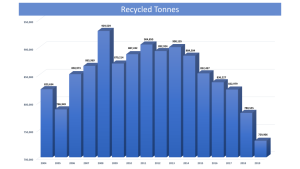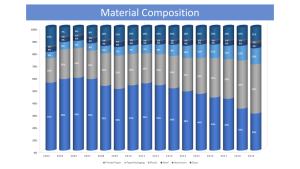Stewardship Ontario’s new 2020 Annual Report provides the most recent data on the performance of the Ontario Blue Box program.
Over 729,000 tonnes of packaging and printed paper were recycled in 2019, the most recent year for which data is available, resulting in a 57.3% recycling rate, down from 60.2% in 2018. The Ontario government’s mandated recycling target is 60 per cent, under the previous regulation.

One of the main reasons noted for the decline in recycled tonnes is due to a reduction in newsprint.
The below Material Composition chart illustrates the decline in the printed paper category (which includes newspapers, magazines, and catalogues), showing it’s gone from 55% in 2004, down to 30% in 2019. Meanwhile, paper packaging has doubled from 20% in 2004, to 40% in 2019.

And access to recycling programs remained high in 2019, with 94% of Ontario households having access to Blue Box programs. Not only do Ontario residents have access, but they actively recycle their paper-based packaging, allowing PPEC’s paper packaging mill members to continue to maintain high levels of recycled content in Canadian made paper packaging.
PPEC has been monitoring the activities related to the Ontario Blue Box program and its transition to the new producer responsibility framework. We have recently participated in webinars hosted by the Ontario Ministry of the Environment, Conservation and Parks (July) and the Resource Productivity and Recovery Authority (August).
PPEC’s key issues concerning the new regulation include the addition of packaging-like products to the Ontario Blue Box program, and the new paper-based recycling targets.
Under the Blue Box Regulation, there are several newly obligated packaging/products including packaging-like products, examples of which that have been provided by RPRA include paper bags and cardboard boxes.
PPEC is monitoring this closely as it pertains to PPEC’s members, who have not historically been obligated stewards of the Ontario Blue Box program. As our members are not directly supplying finished products into the consumer marketplace – and are typically engaging in business-to-business transactions with distributors – we expect this to remain the same, and we will continue to follow this as new information becomes available.
Of importance to PPEC and its members are the new government mandated paper diversion targets laid out in the final Blue Box Regulation: 80% for 2026-2029, and 85% for 2030 and beyond.
PPEC is concerned with the feasibility of achieving the government’s new targets.
As noted above, the overall composition of the paper category has been changing over the years, with newspaper generation continuing to decrease, while other categories, like corrugated boxes, already have high diversion rates, which we believe leaves little room for improvement.

It remains to be seen how the program will achieve the high diversion targets for paper. The hope is that a new producer responsibility model will achieve greater economies of scale, by gaining new efficiencies with collecting, processing, and marketing a more consistent and standardized set of Blue Box materials across the province. This should also result in lower contamination levels, as well as improved consumer behaviour at the household level in source separating wastes from organics and recyclables.
PPEC will be watching the diversion data in the coming years, and we will continue to monitor news related to the transition of the Blue Box program closely.
